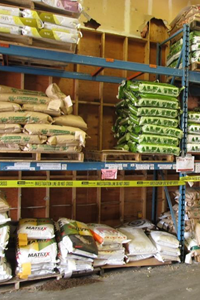Worker became seriously ill after rodent remediation
Date of incident: June 2021
Notice of incident number: 2021124800046
Employer: General retailer
Incident summary
At a retail store and warehouse, workers were cleaning up a rodent infestation when they were exposed to rodent debris, rodenticides, and products of combustion. One of the workers became seriously ill after the exposure.
Investigation conclusions
Cause
- Worker exposed to hazardous substance. The work of opening up the walls in the warehouse to address the rodent infestation required moving palletized stock with a propane-powered forklift, which operated intermittently during the cleanup within the enclosed warehouse. Dead and live rodents, along with material contaminated by the rodents’ urine and feces, were found when the walls were opened. During the two days of remediation work, the worker who became ill was exposed to biological and chemical agents including carbon monoxide fumes from the forklift; pesticides; and rodent matter. On the day after the second day of remediation work, the worker became seriously ill.
Contributing factors
- Lack of hazard identification and risk assessment. The rodent remediation undertaken by the employer involved exposure to significant hazards: a biological agent or agents, and chemical agents (two rodenticides and carbon monoxide). A risk assessment was not undertaken to identify the hazards or the risk of harm to workers and how serious that harm could be.
- Failure to create an exposure control plan. Because there was a potential for workers to be exposed to hazardous substances, the employer was required by the Occupational Health and Safety Regulation to develop and implement an exposure control plan (ECP). The ECP would have involved a risk assessment conducted by a qualified person, and would have identified engineering controls, safe work procedures, and appropriate PPE and other equipment. It would also have specified the type of worker training and supervision necessary to control exposure. The employer did not have an exposure control plan.
- Lack of written safe work procedures. The employer failed to develop written safe work procedures for the rodent remediation, to eliminate or minimize the risk of exposure to a chemical or biological agent. The employer’s failure to develop safe work procedures allowed the worker to use procedures that exposed him to hazardous substances.
- Inadequate personal protective equipment. The employer failed to identify and provide appropriate PPE (including respirators, eye protection, and protective clothing and footwear), which allowed the worker to work in the presence of hazardous substances without effective protection to ensure his health and safety.
- Inadequate cleanup equipment. The employer provided two wet/dry shop vacuums that were not intended for cleaning up hazardous substances. They did not have HEPA filters and may have distributed hazardous substances in the air.
- Lack of training. The employer did not provide workers (including managers) with the information and training necessary to safely carry out the rodent remediation work.
- Inadequate supervision. The supervision that the employer provided for this work was inadequate and ineffective. Workers were not provided with the necessary information to ensure their health and safety. Furthermore, although the employer identified N95 masks as basic mandatory PPE for the work, the use of N95 masks was not enforced.
2021-04-22 20:42:33

